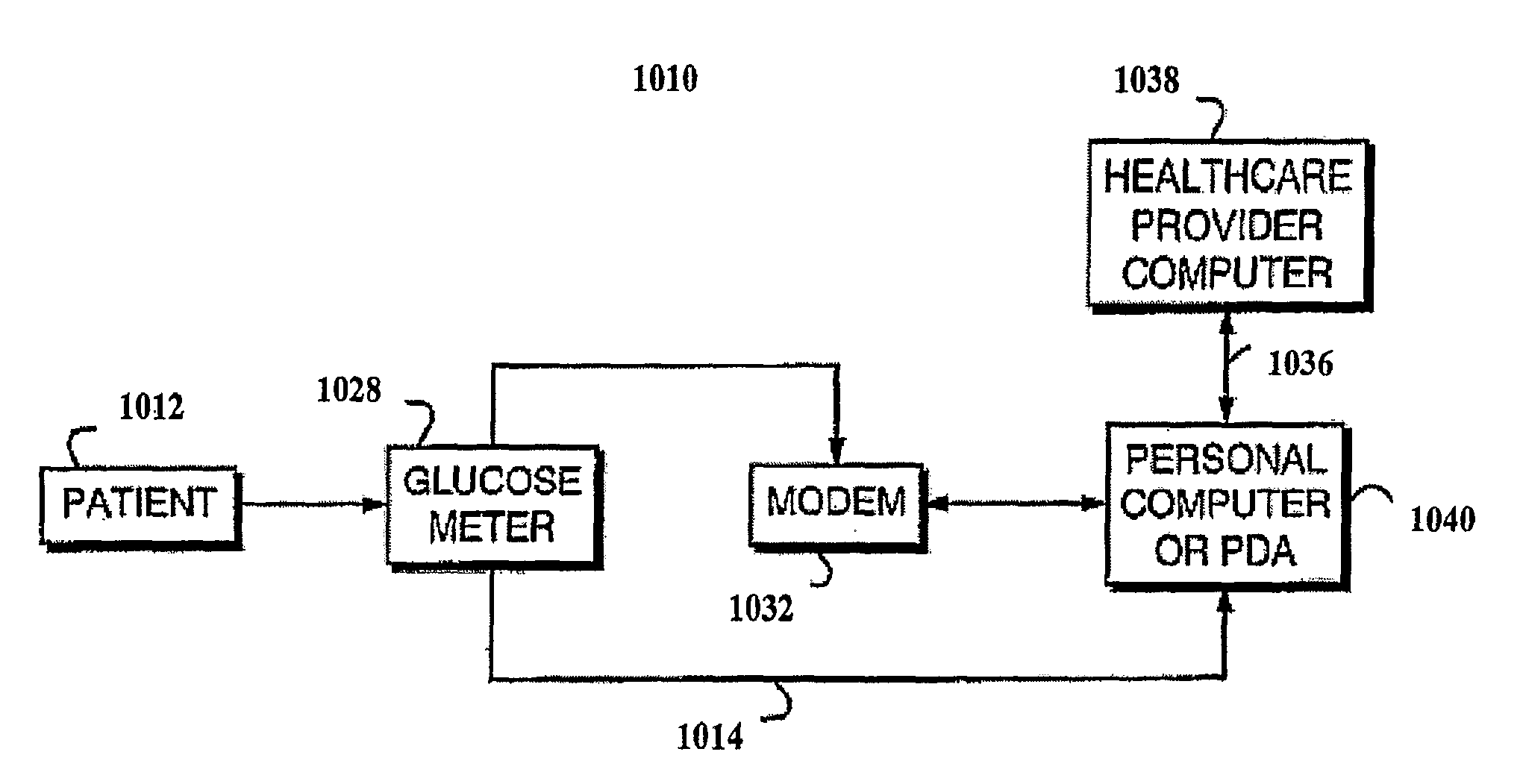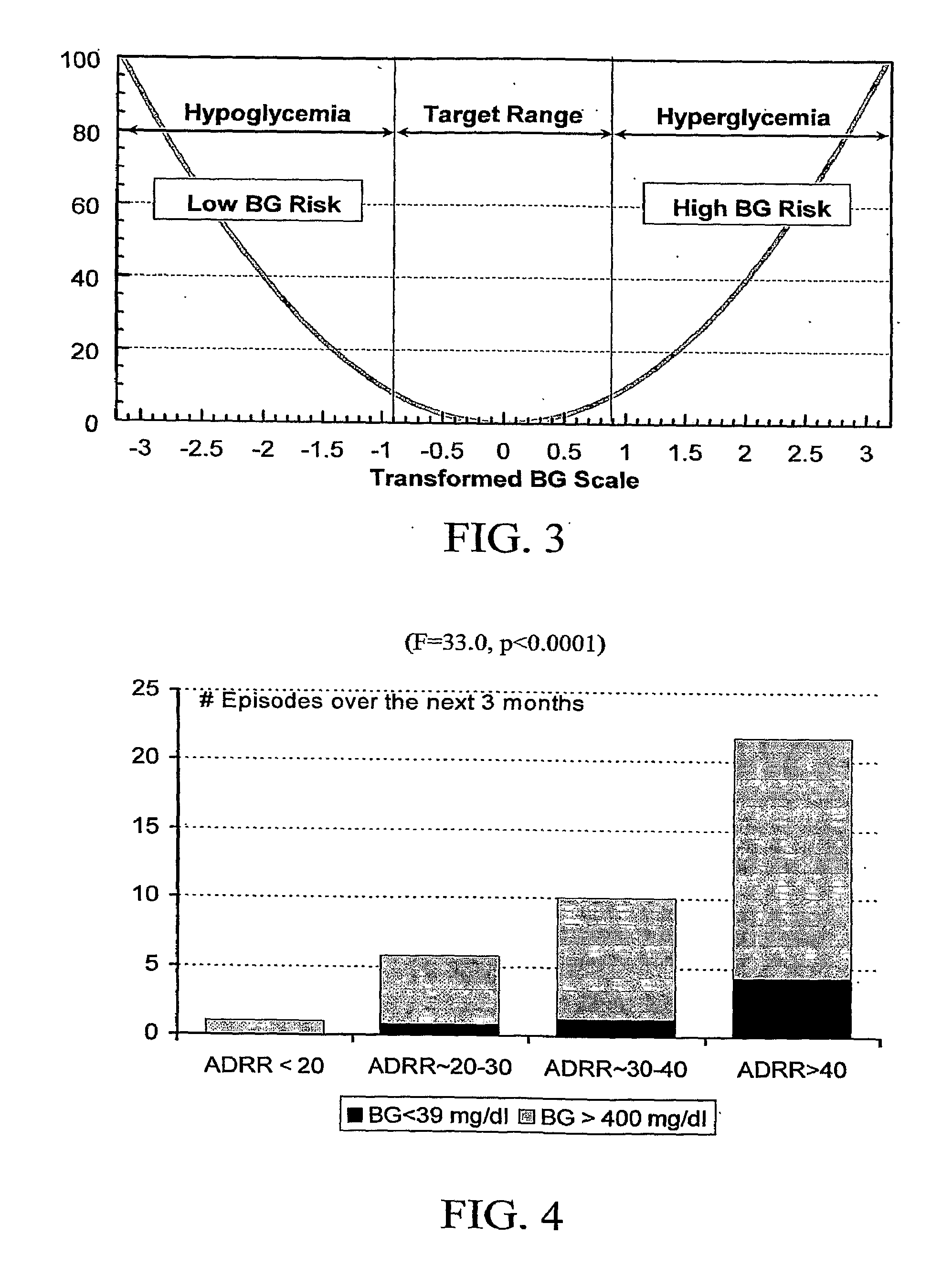Method, System and Computer Program Product for Evaluation of Blood Glucose Variability In Diabetes From Self-Monitoring Data
a self-monitoring and diabetes technology, applied in the field of glucose monitoring, can solve the problems of insensitivity to hypoglycemia, bias towards hyperglycemia, and inability to accurately estimate the constricted hypoglycemic range, and achieve the effect of evaluating the long-term risks of hypoglycemia and hyperglycemia
- Summary
- Abstract
- Description
- Claims
- Application Information
AI Technical Summary
Benefits of technology
Problems solved by technology
Method used
Image
Examples
example a
Relationship of Measures of Glucose Variability with Out of Control Glucose Results
[0288]Background: Evidence is accumulating that glucose excursions may be a significant contributor to the complications in diabetes. In addition, glucose excursions must be minimized to optimally reduce HbA1c. Therefore there is a need to determine measures of glucose variability that can be used to manage and reduce glucose excursions.
[0289]Methods: Using a sample of one month of longitudinal time stamped self-monitoring of blood glucose (SMBG) data from a large dataset of 335 patients, different variability measures used in clinical practice and described in the literature including Standard Deviation (SD), Range, Mean Amplitude of Glycemic Excursion (MAGE), M-Value and the Liability Index were computed and related to the frequency of out of control glucose results (Glucose180 mg / dl) in the subsequent 1 month of patient SMBG results. SD and mean groupings for various HbA1c cohorts were also devised...
example b
Algorithmic Design of an Intelligent Blood Glucose Meter Phase 4 Data File Description and Preliminary Results
Introduction:
[0292]The data collection of Phase 4 was a continuation of a large NIH-funded study NIDDK RO1 DK 51562, “Bio-Behavioral Monitoring and Control of IDDM” with Principal Investigator Boris Kovatchev, specifically of the data from its Hospital-laboratory study (HIC #10714), which investigates metabolic parameters of adults with T1DM during hyperinsulinemic euglycemic clamp and subsequent descent into hypoglycemia with a target level of 40 mg / dl. During this study, metabolic demand and counterregulation data were collected for 39 people with T1DM. The computation of each person's individual metabolic demand (IMD) used the classic DeFronzo's clamp equations, modified by BK to account for non-steady states, such as exercise and hypoglycemia. Counterregulatory response was assessed by a direct measurement of epinephrine levels at baseline and then every 10 minutes durin...
example c
Field Glucose Variability Index is Related to Laboratory Measures of Insulin Sensitivity and Hypoglycemia Counterregulation
[0304]Background and Aims: Contemporary studies increasingly support the idea that blood glucose (BG) variability is a major determinant of diabetes complications; therefore BG variability, along with HbA1c, becomes a major marker of glycemic control in Type 1 and Type 2 diabetes (T1DM, T2DM). However, quantifying glucose variability is not straightforward—traditional variability measures, such as standard deviation (SD), M-value, etc. appear to be mostly dependent on hyperglycemic excursions, ignoring hypoglycemic BG fluctuations and being insensitive to hypoglycemia-related characteristics of T1DM.
[0305]This study introduces a new variability measure computed from routine self-monitoring BG (SMBG) data, the Average Daily Risk Range (ADRR), which is equally sensitive to hypoglycemic and hyperglycemic excursions, and investigates its relationship with laboratory...
PUM
 Login to View More
Login to View More Abstract
Description
Claims
Application Information
 Login to View More
Login to View More - R&D
- Intellectual Property
- Life Sciences
- Materials
- Tech Scout
- Unparalleled Data Quality
- Higher Quality Content
- 60% Fewer Hallucinations
Browse by: Latest US Patents, China's latest patents, Technical Efficacy Thesaurus, Application Domain, Technology Topic, Popular Technical Reports.
© 2025 PatSnap. All rights reserved.Legal|Privacy policy|Modern Slavery Act Transparency Statement|Sitemap|About US| Contact US: help@patsnap.com



